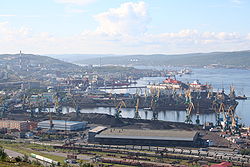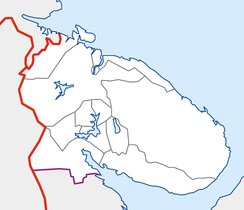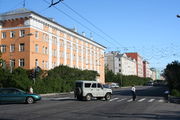Murmansk
| Murmansk (English) Мурманск (Russian) |
|
|---|---|
| — Inhabited locality — | |
 Murmansk Port |
|
.svg.png) Location of Murmansk Oblast in Russia |
|
 Murmansk
|
|
| Coordinates: | |
 |
 |
| Holiday | October 4 |
| Administrative status | |
| Country | Russia |
| Federal subject | Murmansk Oblast |
| Administrative center of | Murmansk Oblast |
| Municipal status | |
| Urban okrug | Murmansk Urban Okrug |
| Head | Sergey Subbotin[1] |
| Representative body | Council of Deputies |
| Statistics | |
| Area | 150.55 km2 (58.13 sq mi) |
| Population (2002 Census) | 336,137 inhabitants[2] |
| - Rank | 52nd |
| - Density | 2,233 /km2 (5,780 /sq mi)[3] |
| Time zone | MSK/MSD (UTC+3/+4) |
| Founded | October 4, 1916 |
| Previous names | Romanov-on-the-Murman (until April 1917) |
| Postal code(s) | 183000..183099 |
| Dialing code(s) | +7 8152 |
| [www.gov-murman.ru/mun/murmansk Official website] | |

Murmansk (Russian: Му́рманск; Northern Sami: Murmanska; Skolt Sami: Muurman) is a city and seaport in the extreme north-west part of Russia, on the Kola Bay, 12 kilometres (7 mi) from the Barents Sea on the northern shore of the Kola Peninsula, not far from Russia's borders with Norway and Finland.
Murmansk is the administrative centre of Murmansk Oblast. The port remains ice-free year round due to the warm North Atlantic drift ocean current and is an important fishing and shipping port. Its satellite, Severomorsk, is an important navy base for the Russian Navy. It is home port to Atomflot, the world's only fleet of nuclear powered icebreakers.[4][5]
Despite its rapidly declining population, Murmansk remains the largest city north of the Arctic Circle. Population: 311,209 (2009 est.); 336,137 (2002 Census);[2] 468,039 (1989 Census).[6]
Contents |
History
Murmansk was the last town founded in the Russian Empire. Murman is a traditional Pomor name for the Barents Sea and derives from the Old Russian word for Norwegians, "Murmane", cognate to the English "Normans".[7]
The city, first known as Romanov-on-the-Murman (Рома́нов-на-Му́рмане), was founded on October 4, 1916 and named after the royal Russian dynasty of Romanovs. The city, the only ice-free port in the Russian Arctic, was built as a terminus for the railway line to Kola designed to open the North Atlantic supply route to Russia in support of the Eastern Front during the First World War. The city was renamed Murmansk after the February Revolution in 1917.
From 1918 to 1920, the city was occupied by the Western powers who had been allied in the First World War and "White" forces during the Civil War in Russia.[8]
During World War II, Murmansk was a link with the Western world for Russia, with large quantites of goods important to the respective military efforts traded with the Allies: primarily manufactured goods and raw materials into the Soviet Union. The supplies were brought to the city in the Arctic Convoys.
German forces in Finnish territory launched an offensive against the city in 1941 as part of Operation Silver Fox, and Murmansk suffered extensive destruction, second only to Leningrad and Stalingrad of all Soviet cities.[9][10] However, fierce Soviet resistance and harsh geography prevented the Germans from capturing the city and cutting off the vital Karelian railway line and the ice-free harbour. For the rest of the war, it served as transit point for weapons and other supplies entering the Soviet Union from other Allied nations. This unyielding resistance was commemorated at the 40-year anniversary of the victory over the Germans in the formal designation of Murmansk as a Hero City on May 6, 1985.[11] During the Cold War Murmansk was a centre of Soviet submarine and icebreaker activity and, past the breakup of the Soviet Union, the nearby city and naval base of Severomorsk remains the headquarters of the Russian Northern Fleet.
In 1974, a massive 35.5-metre-tall statue Alyosha, depicting a Russian World War II soldier, on a 7-metre-high foundation, was erected overlooking the city harbour.[12]
To commemorate the 85th anniversary of the city's foundation, the snow-white church of the Saviour-on-the-Waters was modeled after the White Monuments of Vladimir and Suzdal and built on the shore for the sailors of Murmansk (photograph).
Murmansk's evening newspaper is Vecherny Murmansk, published since 1991.
The city is home to the world's northernmost Jewish synagogue at 68°58' N latitude.[13]
Transport
The port of Murmansk is the headquarters of Sevmorput the administration of Russian Arctic maritime transport and is also home port to most Russian Nuclear icebreakers.
Murmansk is linked by the Murmansk Railway to St Petersburg and is also linked to the rest of Russia by the M18 Kola Motorway. Murmansk Airport provides air links to Moscow and St Petersburg.
Local public transport consists of buses and trolleybuses.
Arctic Bridge

Murmansk is set to be the Russian terminus of the Arctic Bridge (or Arctic Sea Bridge), a sea route linking it to the Canadian port of Churchill, Manitoba. The passage has not been fully tested for commercial shipping yet but Russia has shown interest in it. It is believed that, once developed (along with the Northwest Passage), the bridge will serve as major trade route between Europe and Asia.
The international seminar devoted to “Cooperation between Russia and Canada on offshore gas and oil fields” took place in the framework of International Forum SEVTEK - 2008 (Northern energy complex). More detailed information you can read here [1]
Education
Murmansk is home to the Murmansk State Technical University, the Murmansk State Pedagogical University and the Murmansk Institute of Humanities
Murmansk also has 86 primary schools and 56 secondary schools, 2 boarding schools and 3 reform schools.
Sport
The city football team, FC Sever Murmansk plays in the Russian Second Division.
The Murman Hockey club is the most northerly ice hockey club in the world.
Murman plays in the highest division of the Russian Bandy League. And the city is one of only three places with representation in the female league, through the team Arktika
Culture
Murmansk has two museums: The Murmansk Oblast Museum and the Murmansk Oblast Art Museum. There are also three professional theatres in Murmansk.
People from Murmansk
- Nikita Alexeev – KHL ice hockey player
- Aleksey Goman – Russian Pop singer
- Irina Kovalenko – Supermodel and Miss Russia winner
- Vladimir Konstantinov – NHL ice hockey player
- Larisa Kruglova – sprinter
- Sergey Kuryokhin – actor and musician
- Irina Malgina – Biathlete
- Sergey Rozhkov – Biathlete
- Alexei Semenov – NHL ice hockey player
- Avraham Shmulevich – Israeli Politician
Twin Towns/Sister Cities
Murmansk is twinned or has sister city relationships with:
Climate
| Climate data for Murmansk | |||||||||||||
|---|---|---|---|---|---|---|---|---|---|---|---|---|---|
| Month | Jan | Feb | Mar | Apr | May | Jun | Jul | Aug | Sep | Oct | Nov | Dec | Year |
| Source: Pogoda.ru.net[16] | |||||||||||||
References
Notes
- ↑ "New face of the city of Murmansk". Barentsnova.com. http://barentsnova.com/news/show/1132. Retrieved 2009-03-17.
- ↑ 2.0 2.1 Федеральная служба государственной статистики (Federal State Statistics Service) (2004-05-21). "Численность населения России, субъектов Российской Федерации в составе федеральных округов, районов, городских поселений, сельских населённых пунктов – районных центров и сельских населённых пунктов с населением 3 тысячи и более человек (Population of Russia, its federal districts, federal subjects, districts, urban localities, rural localities—administrative centers, and rural localities with population of over 3,000)" (in Russian). Всероссийская перепись населения 2002 года (All-Russia Population Census of 2002). Federal State Statistics Service. http://perepis2002.ru/ct/html/TOM_01_04_1.htm. Retrieved 2009-08-19.
- ↑ The value of density was calculated automatically by dividing the 2002 Census population by the area specified in the infobox. Please note that this value may not be accurate as the area specified in the infobox does not necessarily correspond to the area of the entity proper or is reported for the same year as the Census (2002).
- ↑ MSCO: Fleet: Icebreaking fleet
- ↑ "Atomflot – Bellona". Bellona<!. http://www.bellona.org/english_import_area/international/russia/civilian_nuclear_vessels/radwaste/30138. Retrieved 2009-05-05.
- ↑ "Всесоюзная перепись населения 1989 г. Численность наличного населения союзных и автономных республик, автономных областей и округов, краёв, областей, районов, городских поселений и сёл-райцентров. (All Union Population Census of 1989. Present population of union and autonomous republics, autonomous oblasts and okrugs, krais, oblasts, districts, urban settlements, and villages serving as district administrative centers.)" (in Russian). Всесоюзная перепись населения 1989 года (All-Union Population Census of 1989). Demoscope Weekly (website of the Institute of Demographics of the State University—Higher School of Economics. 1989. http://demoscope.ru/weekly/ssp/rus89_reg.php. Retrieved 2007-12-13.
- ↑ Max Vasmer's Etymological Dictionary, trans. by Oleg Trubachev, vol. 3, p. 13.
- ↑ "Bolshevik, North Russian, Royal Navy, Expeditionary Force, Archangel, Dvina River". Naval-history.net. http://www.naval-history.net/WW1z05NorthRussia.htm. Retrieved 2009-05-05.
- ↑ Мурманску исполняется 90 лет(Russian)
- ↑ Газета «Вечерний Мурманск» Выпуск № 93 от 28 мая 2005 (Russian)
- ↑ "Nature » Administrative-territorial system". 2004.murman.ru. 1916-10-04. http://2004.murman.ru/nature/adm_delenie/murmansk/index-eng.shtml. Retrieved 2009-05-05.
- ↑ "Известия.Ру: 7 чудес России". Izvestia.ru. http://www.izvestia.ru/miracles/12.html. Retrieved 2009-05-05.
- ↑ "Synagogues at extreme latitudes". Safon.org. 2007-09-28. http://safon.org/en/index.php?title=Synagogues_at_extreme_latitudes. Retrieved 2009-05-05.
- ↑ "Kaliningrad -Partner Cities". © 2000-2006 Kaliningrad City Hall. http://www.klgd.ru/en/search/index.php?q=partner+cities&where=. Retrieved 2008-12-08.
- ↑ "Groningen — Partner Cities". © 2008 Gemeente Groningen, Kreupelstraat 1,9712 HW Groningen. http://www.groningen.nl/functies/pagfunctie.cfm?parameter=1285. Retrieved 2008-12-08.
- ↑ "Pogoda.ru.net" (in Russian). http://pogoda.ru.net/climate/22113.htm. Retrieved September 8, 2007.
External links
- Murmansk: Info, News, Photo
- Murmansk: on-line map, city guide
- Murmansk Travelling Agent
- Atomic ice breaker fleet
- Murmansk's gorgeous garages — a photo journal by BBC news journalist Jorn Madslien
- Murmansk travel guide
- Satellite picture by Google Maps
- Map of Murmansk
- Views of Murmansk group on Flickr
- Video overview of Murmansk in English, 4½ minutes, 2009
- Murmansk State Technical University
- British North Russian Expeditionary Force 1918–1919 (based at Murmansk)
- "Big-dollar deals tempt Arctic firms" BBC article on the energy industry's effect on Murmansk
- Image of "Alyosha" statue
|
||||||||||||||
|
|||||